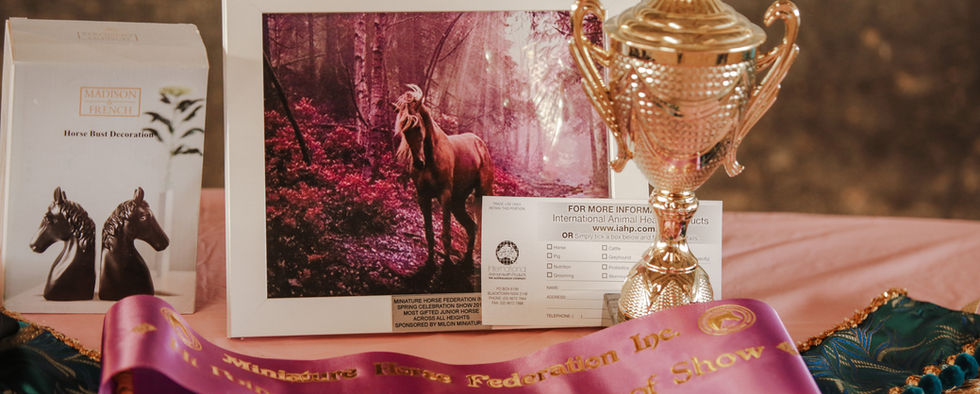
Miniature Horse Federation Inc.









COMMAND RESPONSE - SENIOR
Horses must be 48 months of actual age or over to compete in this event
The horse is NOT to be judged on conformation or quality of movement. This discipline is to be judged solely on the horse’s willingness and response to each exercise.
The object of this discipline is to maintain LIGHT contact with the horse through the lead throughout all exercise’s.
In each of the exercises at walk and trot the horse is to maintain the same position to handler e.g. Handler at the head of the horse, or handler at the shoulder of the horse.
Course
The judge will pick any 3 of the disciplines below, the discipline can be in any order although the sequence within the discipline needs to be followed. Then the judge or steward will call each part of the discipline aloud for the competitor to then follow: -
-
Discipline 1
-
Walk on 6 to 10 steps
-
Trot on 6 to 10 steps
-
Increase pace at trot 6 to 10 steps
-
Decrease pace at trot 6 to 10 steps
-
Walk 6 to 10 Steps
-
Halt
-
-
Discipline 2
-
Horse to remain at halt while the handler walks out to the front of the horse and halts for 3 seconds.
-
From the front, the handler walks down the near side (left side) towards the rump and halts for 3 seconds.
-
The handler then returns to the front of the horse, before continuing down the off side (right side) towards the rump and halt for 3 seconds.
-
Horse must remain at halt throughout.
-
-
Discipline 3
-
From halt horse to back 4 to 6 steps and halt
-
From halt horse to trot off
-
From trot horse to halt
-
-
Discipline 4
-
From halt horse to move whole body away from handler towards offside (right side)
-
From halt horse to move whole body away from handler towards near side (left side)
-
-
Discipline 5
-
At walk horse to move away from handler (to the side) to end of lead and back towards handler maintaining an even pace.
-
At trot horse to move away from handler (to the side) to end of lead and back towards handler maintaining an even pace.
-
Commands may be communicated to the horse through voice, by hand signals and pointing.
If on the second attempt the horse fails to complete an exercise, is it to continue to the next exercise.
Scoring
Horses are to be given a score of 50 with penalties taken off and highest points in consecutive places
Horses are to be given credit for
-
Maintaining the same position to the handler
-
Maintaining light contact through the lead
-
Willingness and evenness of going
-
An alert co-operative attitude
Penalties – 4 points for
-
The handler touching the horse or the horse touching the handler
-
Pulling or dragging on the lead by either the horse or the handler
-
Horse running away from the handler
-
Refusal to move when directed by the handler
-
Aggressively shaking of the lead rope to intimidate horse to move away by the handler
-
Physically pushing the horse or poking the horse to make it move in any direction
-
Backing horse by aggressively shaking the lead rope
-
The horse showing fear or resentment towards the handler throughout the course
-
Swinging the lead rope threateningly
Disqualification
-
If at any time a handler strikes the horse
-
Carrying a whip
-
Blatant disobedience of horse (kicking out, bucking, rearing, striking)
-
Having a bit in the horse’s mouth
-
Leaving arena without permission of the Judge or Steward
-
Exhibitor disrespectful towards the judge(s)
Equipment
-
Halters can be made of leather, plastic or webbing that sits flat against the horse’s head and across the nose. No buckle is to be on the noseband. Rope halters are allowed as long as the knots are not positioned to be used as pressure point areas on the horse’s head and face, for example knots should not be on the bridge of the nose they can be to each side. Knots cannot be behind the poll.
-
The lead can be flat as in webbing or rounded and must attach under the chinstrap. The lead attachment can be a loop, which the lead threads back through or it can be a clip with a swivel. The lead must not be shorter than 1.8 metres (6 feet) and it should not be longer than 2.4 metres (8 feet).
Prohibited Equipment
-
Whips or any other object other than stated in Acceptable equipment
-
Chains either in mouth, under or over face of the horse, nor can they be attached to the lead
-
Bridles and bits
-
Wrapping of any kind anywhere on the halter that could conceal any pressure knots or objects
-
Any gear that is used for a head check.
Appropriate Attire for Handler
As in all MHF Inc Shows the handlers must be dressed according to the show rules dress code








